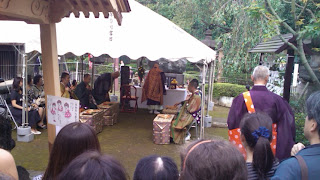I was introduced to Professor Ikegami Yoshimasa from Komazawa University by one of my professors. Our meeting left a great impression on me: I did not only gain several new insights, I am now also able to put insights I already had into words.
First of all, I explained to him that I started off with the intention to compare ancient European pagan syncretism with Japanese syncretism (and more particularly involving the household worship), but that I realised a simple comparison is not suited for a doctoral dissertation and was now looking for historical sources concerning the Ebisu-dana, as it united syncretism and household worship. I made it clear that I was trying to focus on the folkloric aspect of religion, rather than the ideology and professor Ikegami was kind enough to give me some books and texts concerning the so-called Minzoku-gaku “民俗学” (folkloristics).
Professor Ikegami warned me for the risk of ending up simply translating Japanese research concerning the Ebisu-dana. While this kind of research is common and also useful for other researchers who may have limited access to Japanese sources, it is not the best option for a doctoral thesis. He advised me to “zoom out” for the time being to be able to find the right approach. Rather than that, he suggested that I should use my European background and that it may be interesting to do some sort of comparison after all. However, I got the impression that he believed comparing ancient Europe to modern Japan to be slightly stereotypical and perhaps even Eurocentric (“Europeans have surpassed this kind of religion a long time ago”). As I obviously did not intend such a value judgement and I am rather unfamiliar with church-related practices of the Christian era in Europa I was not inclined to go down that road at first. However, the way he defined religion made me change my mind. He says the concept of “believing” is often overly emphasized as a consequence of the predominant influence of Christianity (in particular Protestantism) on modern science. The observing of certain folk ceremonies or rituals, the construction and usage of religious objects and praying for “worldly benefits” is generally disregarded or at least deemed inferior to “faith” by theologian and religious leaders of the modern time. However, this obviously subjective view is often adopted by scholars, perhaps without them even realizing the subjectivity of their approach.
In short, observing “Sinterklaas”, celebrating “Carnaval”, exchanging Christmas gifts or hiding chocolate eggs in the garden for children to find at Easter, as well as praying for a good result on an exam to the kami-dana, throwing beans at Setsubun 節分, dressing up as a Namahage, placing kadomatsu 門松 near the entrance around New Year and so forth are as much entitled to be called “religion” as actual “faith” is. Practical religion (宗教 shūkyō) is in no way objectively inferior to faith (信仰 Shinkō) and therefore deserves equal academic attention.
Professor Ikegami spent a lot of time doing research on the so-called Gense riyaku 現世利益 or the acquisition of “benefits of this world”. Japanese religion is often stereotyped as being focussed mainly on ceremonies that involve such “superficial benefits”. However, it can be misleading to compare Japanese folk religion with Christianity and using hard-core Lutheran theology to represent the latter. Christianity (and perhaps Catholicism in particular) used to be much more of a “practical religion” than we often think. The practice of praying to saints (an obvious remain of pagan polytheism!) for protection, fertility and the like is an example of a ceremony clearly aiming for the acquisition of gense riyaku.
With a definition like that, I am more inclined to compare European religious folklore with its Japanese counterpart in an attempt to prove that Japanese religion is not the only one that revolves around practical aspects and worldly benefits.
Two problems arise, however, if I choose to change my strategy:
- I have to reconsider the period I will be focussing on.
At this point the 17th century seems an option (Japan: pre-shinbutsu bunri period, but a fair amount of sources concerning folk culture. Europe: Renaissance period, a lot of attention for pre-christian religion [albeit not in the sense of “faith”], highly documented folk culture and religion, the origin of customs like St. Nicholas eve)
Or the 19th century were native religious elements were “rediscovered” and stripped from foreign elements (Christianity and Buddhism) in search of national identity (Japan: kokugaku, construction of the concept of kamidana etc. Europe: revival of possibly pre-Christian religious remains, this time approached somewhat diminutively [cfr. Jacob Grimm]).
- Combining the Ebisu-dana with the aforementioned strategy may prove to be difficult.
Further reading will be necessary to determine what strategy would make the greatest contribution to the current debates in folkloristics.
Sources:
Ikegami, Yoshimasa (池上良正).『現世利益と世界宗教』(Gense riyaku to sekai shūkyō). Tokyo: Iwanami shoten (岩波書店), 2004.
















